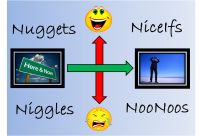 Improvements need to be sustained – but not forever.
Improvements need to be sustained – but not forever.
They should be worthwhile on their own and also provide a foundation for future improvement.
Improvement flows and it does so down the path of least resistance. Improvement will not flow up the path of most resistance. And resistance to flow is called a constraint.
Many things flow: water, energy, money, data, ideas, knowledge, influence – the list is endless – so the list of possible constraints is also endless. But not all constraints are the same: a constraint that limits the flow of water – a dam for instance – does not limit the flow of ideas.
The flows and their constraints can be arranged on a contiuum with one end labelled “Physics” and the other end labelled “Paradigms”. Physical flows are constrained by the Laws of the Universe which are absolute and stable. Philosophical flows are constrained by beliefs which are arbitrary and mutable.
This spectrum is often viewed as a hierarchy – with Paradigms at the top and Physics at the bottom – and between these limits there is a contiuum of constraints. The Paradigm is completely abstract and intangible and is made actual through Policy, guided by Politics, and enforced by Police. The root of all these words is “poli” which means “many” and implies the collective of people. So, a Policy is an arbitrary constraint that limits what is and what is not allowed. It is the social white line that indicates what behaviours the collective expect from the individual. A Policy is implemented as a Process.
What actually happens is constrained by the Physics. Irrespective of the Paradigm, Policy and Process – if the Laws of Physics say something is impossible then it does not happen. It is impossible to squeeze, store or reverse time. It is impossible to do something that requires 30 mins of time in 5 minutes; it is impossible to store time to use later; it is impossible to rewind time go back to a previous point in time.
From the perspective of reality our hierarchy of constraints is upside down – Physics dictates what is possible irrespective of what the Paradigm indicates is believable. What is believable may not be possible; and what is possible may not be believed.
Improvement Science is the art of the possible – of what the Laws of Physics do not forbid – a wide vista of opportunity. It is now that our Paradigm acts as the constraint – and Improvement Science is the ability to challenge our Paradigm. Only then can we create the Policy and the Process that will deliver actual, valuable and sustainable improvement.
Some parts of our Paradigm are necessary to provide explanation and meaning. Other parts are not needed – they are our “belief baggage” – the assumptions that we have picked up along the way; the mumbo-jumbo that obscures the true message. When we focus on the mumbo-jumbo we miss the message and we open the door to cynicism and distrust.
Our challenge is to separate the two – the wheat from the chaff; the diamond from the dross and the pearl-of-wisdom hidden in the ocean-of-data. What do we actively include? What do we actively exclude? What do we actively remove? What do we actively improve? We need to monitor all four parts of our Paradigm and that task is what The 4N Chart® was designed to help us do.
Click here get The 4N Chart template and here to get The 4N Chart instructions.
